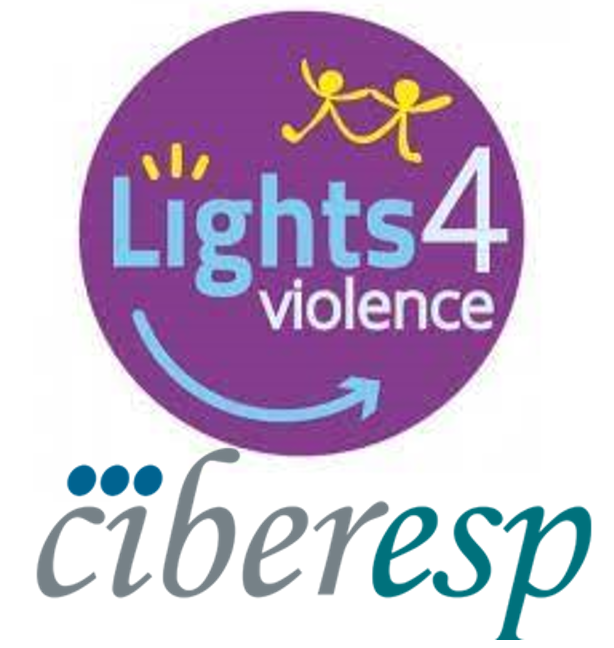1. EDITORIAL ........................................................................................................... 3
2. OVERVIEW OF OUR ACTIVITIES ........................................................................ 5
2.1. DISSEMINATION ACTIVITIES .................................................................................... 5
2.1.1. Journals .......................................................................................................... 5
2.1.2. Conferences.................................................................................................... 9
2.2. COMMUNICATION ACTIVITIES ............................................................................... 10
2.3. FIELDWORK ACTIVITIES ........................................................................................ 13
3. RELEVANT NEWS .............................................................................................. 23
4. FORTHCOMING ..................................................................................................... 38
1. EDITORIAL
On the 22-24th May 2019 the Council of Europe held its 15th Gender Equality Commission meeting in Strasbourg. This commission exists to promote balanced participation of women and men in positions of political influence, to provide a platform for agreed action in tackling discrimination and preventing and combating violence against women. The commission have worked hard to push for changes in legislation to protect and empower women and is now considering steps to implement these legal frameworks to ensure that member nations act, not just agree that action is necessary. Around the same time our Lights4Violence project in schools across Europe have been drawing to a conclusion, meaning that hundreds of school children have been thinking and acting on similar issues. The children may have done this in different ways, exploring with their peer groups, learning together sharing their message and skills; but the expected outcome is very similar –better love relationships and greater equality between partners.
In Wales the children have focused on the importance of positive peer relationships, communication and family support in order to prevent or address issues in relationships including; jealousy, aggression, substance misuse and dating violence. The project is being piloted across Europe using control groups school children and the results of the study will be released in October. In the meanwhile, the Government in Wales set out a national strategy recognizing that violence against women is a violation of human rights grounded in gender inequality. Such a strategy aims at making Wales a safer and healthier nation by implementing ad hoc interventions and legal frameworks, including piloting specific domestic violence courts with specifically trained staff etc. These initiatives have come in response to Wales recording highest rates of both officially reported (crimes, police statistics) and unofficial reports (crime survey) of domestic abuse in the UK. The National Strategy for Violence Against Women, Domestic Abuse and Sexual Violence (VAWDASV) 2016- 2021 is one response to these issues. The Welsh government have also launched the Live Fear Free website, providing information and advice for those suffering with violence against women, domestic abuse and sexual violence. The website links to support organisations and campaigns designed to raise awareness, such as “This is not love. This is control” which has been designed to raise awareness of the behaviours associated with coercive control. This website has provided easy access to support and services for anyone suffering from violence or anyone concerned for their friends or family.
Prevention is a priority for this work, with primary and early intervention being key priorities for the Welsh Government which, through VAWDASV, stipulates that prevention is everyone’s business and encourages all sectors to work together to do this. Research shows that experiencing dating violence as a teenager, whether as a perpetrator or victim, increases the risk of repeating the experience in to adulthood. Therefore, it is important to work with young people to provide them with the skills they may need to choose and engage in healthy relationships. Lights4Violence is designed as a primary/early intervention to be delivered with children in schools (13-15yrs) to prevent dating violence emerging in teenage relationships. The project aims to provide students with skills that contribute to promoting equality and raise awareness about the importance of positive interpersonal relationships. It focusses on positive assets (i.e., “protective factors”) and healthy love relationships, and is delivered using peer learning methods, including role play, scripting, and acting to create short films that the students can use to both learn and teach others about positive relationship skills.
The aim of Lights4Violence is then primarily to improve health and well-being, but by doing so, to reduce the risk of violence in relationships both in adolescence but also into adulthood. The project is being piloted in Wales as well as in the other partner countries, and evaluated using robust research methodologies and including a control group in order to explore the impact the intervention has on the health of young people, but also on the factors associated with dating violence. We hope that Lights4Violence provides one means by which schools can be effectively engaged with this priority in making Wales a safer place.
Edited by the team of CARDIFF METROPOLITAN UNIVERSITY (UWIC) United Kingdom
Lights4Violence team at the Meeting in Cardiff, March 2019 NEWSLETTER – MAY 2019
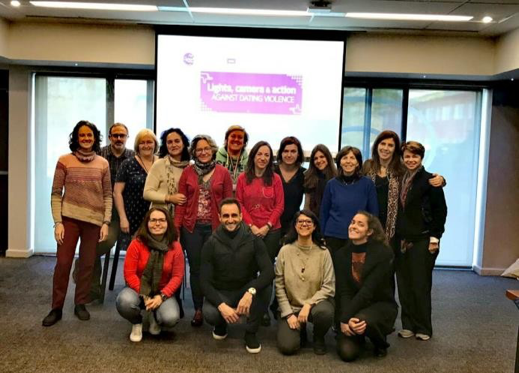
2. OVERVIEW OF OUR ACTIVITIES
2.1. DISSEMINATION ACTIVITIES
2.1.1. Journals
A colective publication, in which many project partners participated, accounts for the main features of Lights4Violenceas a project, and the effectiveness of its educational interventions combining a positive youth development framework with the awareness about the importance of fostering gender equality while preventing gender violence. In the study protocol, violence prevention apprach is integrated by promoting protective factors against gender violence such as communication skills, empathy and problem-solving skills through "Cinema Voice", a participatory educational intervention based on adolescents' strengths. The educational intervention is aimed at boys and girls aged between 13 and 17, enrolled in secondary schools in Alicante (Spain), Rome (Italy), Cardiff (United Kingdom), Iasi (Romania), Poznan (Poland) and Matosinhos (Portugal).
Reference: Vives-Cases C, Davo-Blanes MC, Ferrer-Cascales R, Sanz-Barbero B, Albaladejo-Blázquez N, Sánchez-San Segundo M, Lillo-Crespo M, Bowes N, Neves S, Mocanu V, Carausu EM, Pyżalski J, Forjaz MJ, Chmura-Rutkowska I, Vieira CP, Corradi C. (2019). Lights4Violence: a quasi-experimental educational intervention in six European countries to promote positive relationships among adolescents. BMC Public Health, 19(1):389. doi: 10.1186/s12889-019-6726-0.
___________________________________________________
Carmen Vives-Cases and her colleagues analysed training on gender-based violence that nursing students receive at universities in Spain through a systematic review of public documents followed by in-depth interviews with university lecturers. Results show that 80% (92/115) of nursing training programmes included content regarding gender-based violence. There was great variability in the topics included in the training. Health consequences due to gender-based violence exposure and the role of the health sector in addressing these health consequences were the most frequently included topics. Ethical issues and legislation were the least frequent ones, as these were only dealt with in one and 18 training programmes, respectively. In the qualitative analysis of the interviews, two categories were identified: 'Supportive legislation and supportive lecturers are essential for integrating gender-based violence training' and 'Approach to gender-based violence shapes the contents and the subject in which it is incorporated'. The first category refers to the main drivers for training integration, while the second category refers to how lecturers' perceptions influenced the way in which training was implemented.
Reference: Maquibar A., Estalella I., Vives-Cases C., Hurtig A.K., Goicolea I. (2019). Analysing training in gender-based violence for undergraduate nursing students in Spain: A mixed-methods study. Nurse Educ Today, 77:71-76. doi: 10.1016/j.nedt.2019.01.017.
___________________________________________________
Sanz-Barbero and colleagues from different èartner countries describe and analyze whether a relationship exists between gender equality and political responses to gender violence (GV) against women with physical and/or sexual intimate partner violence (IPV) in the European Union (EU). They analyzed a subsample of 39,269 ever-partnered women aged 18 and older from the violence against women survey (2012) of the EU Agency for Fundamental Rights. Outcome was last 12 months physical and/or sexual IPV. Multilevel Poisson regression models were used. Results show that current prevalence of IPV was 4.2%. Having suffered abuse by an adult before age 15 was the strongest associated factor for increasing the probability of suffering (PR: 2.9). Living in countries with higher gender equality, with anti-GV legislation prior to 2005, in countries where the state involved multiple actors in GV response and in countries with family policies included in the Anglo-Saxon, Eastern European and Southern European typologies (reference: Nordic), diminishes the women likelihood of suffering IPV. Therefore, the response to IPV in the EU requires an integral approach that accounts for the efforts of multiple sectors as well as policies that reach greater levels of gender equality in the countries.
Reference: Sanz-Barbero B., Corradi C., Otero-García L., Ayala A., Vives-Cases C. (2018). The effect of macrosocialpolicies on violence against women: a multilevel study in 28 European countries. Int J Public Health, 63(8):901-911. doi: 10.1007/s00038-018-1143-1.
___________________________________________________
The study carried out by Sanz-Barbero, Vives-Cases and their collegaues analyses the effect and impact of heat waves on the risk of IPV through an ecological, longitudinal time series study. The dependent variables are: intimate partner femicides (IPF), reports of IPV and 016 IPV telephone help line calls in the Community of Madrid from 05/01 to 09/30 in the years 2008-2016. The principal independent variable is the daily maximum temperature in Celsius (Tmax) above the heat wave threshold of 34 °C. A binomial negative regression was used for calls and reports and a Poisson regression was used for IPF. The attributable risk among those exposed (AR%) and the number of attributable cases was calculated for each variable. Results show that the risk of IPF increased three days after the heat wave, [RR(IC95%):1.40(1.00-1.97)], police reports of IPV increased one day after [RR (IC95%):1.02(1.00-1.03) and help line calls increased five days after [RR(IC95%):1.01(1.00-1.03)]. The AR% was 28.8% (IC95%: 0.3%-49.2%) for IPF, 1.7% (IC95%:0.3%-3.1%) for police reports and 1.43% (IC95:0.1%;2.8%) for help line calls. This means that heat waves are associated with an increase in IPV. The effect of an increase in IPV is delayed in time, with differences according to the violence indicators analyzed.
Reference: Sanz-Barbero B., Linares C., Vives-Cases C., González J.L., López-Ossorio J.J., Díaz J. (2018). Heat wave and the risk of intimate partner violence. Sci Total Environ, 644:413-419. doi: 10.1016/j.scitotenv.2018.06.368.
___________________________________________________
Otero-García and colleagues explored how health professionals perceived the effect of the economic crisis and associated austerity measures on the detection of and cares for intimate partner violence (IPV) in primary care in Spain. They carried out a qualitative study designed using semi-structured interviews carried out with 145 health professionals in 16 primary health care centres in different regions of Spain. An inductive thematic analysis was made of the transcriptions. Results show three main themes: 'Women endure more violence during times of economic crisis', 'Fewer resources, fewer professionals and less time to respond to IPV' and 'Professionals' motivation as a requirement to respond to IPV'. Professionals perceived that economic precariousness triggered violence against women and made women more hesitant to put an end to violent relationships. They also reported that the austerity measures applied to primary health care negatively affected their ability to detect and adequately care for cases of IPV due to a heavy workload, reduced human resources, difficulties in training and the loss of resources to which women could be referred. To counteract these obstacles, health professionals' motivation played a vital role in the response to IPV. And this is the reason why institutional efforts to organize awareness programmes and training in order to improve and promote early diagnosis, care and rehabilitation of these women cannot stop during times of crisis and primary health care centresshould facilitate health professionals' access to these programmes.
Reference: Otero-García L, Briones-Vozmediano E, Vives-Cases C, García-Quinto M, Sanz-Barbero B, Goicolea I. (2018). A qualitative study on primary health care responses to intimate partner violence during the economic crisis in Spain. Eur J Public Health,28(6):1000-1005. doi: 10.1093/eurpub/cky095.
___________________________________________________
Our collegues from Spain participated in a paper which analyzes whether there are time patterns in different intimate partner violence (IPV) indicators and aims to obtain models that can predict the behavior of these time series. Univariate autoregressive moving average models were used to analyze the time series corresponding to the number of daily calls to the 016 telephone IPV helpline and the number of daily police reports filed in the Community of Madrid during the period 2008–2015. Predictions were made for both dependent variables for 2016. Results show that the daily number of calls to the 016 telephone IPV helpline decreased during January 2008–April 2012 and increased during April 2012–December 2015. No statistically significant change was observed in the trend of the number of daily IPV police reports. The number of IPV police reports filed increased on weekends and on Christmas holidays. The number of calls to the 016 IPV help line increased on Mondays. Using data from 2008 to 2015, the univariate autoregressive moving average models predicted 64.2% of calls to the 016 telephone IPV helpline and 73.2% of police reports filed during 2016 in the Community of Madrid. Therefore, results suggest the need for an increase in police and judicial resources on nonwork days. Also, the 016 telephone IPV helpline should be especially active on work days.
Reference: Sanz-Barbero B, Linares C, Vives-CasesC, González JL, López-Ossorio JJ, Díaz J. (2018). Intimate partner violence in Madrid: a time series analysis (2008-2016). Ann Epidemiol, 28(9):635-640. doi: 10.1016/j.annepidem.2018.05.007
___________________________________________________
Spanish members of the project toghterer with other collegues assessed the prevalence and main characteristics of experiencing physical and/or sexual and psychological-only IPV among young women in the European Union and to identify individual and contextual associated risk factors. They analysed a cross-sectional subsample of 5976 ever-partnered women aged 18-29 years from the European Union Agency for Fundamental Rights Violence Against Women Survey, 2012. The main outcomes were current physical and/or sexual IPV and lifetime psychological-only IPV. Risk factors were assessed by the prevalence ratio (PR) from multilevel Poisson regression models. Results show that the current prevalence of physical and/or sexual IPV was 6.1%, lifetime prevalence of psychological-only IPV was 28.7%. Having suffered physical and/or sexual abuse by an adult before age 15 was the strongest risk factor for IPV (PR: 2.9 for physical and/or sexual IPV, PR: 1.5 for psychological-only IPV). Other individual risk factors were: perceived major difficulties in living within their household income (PR: 2.6), having children (PR: 1.8) and age 18-24 years (PR: 1.5) for physical/sexual IPV and immigration background for psychological-only IPV (PR: 1.4). Living in countries with a higher prevalence of binge drinking or early school dropout was positively associated with IPV. Therefore, findings show that the fight against violence in young women should consider individual characteristics, childhood experiences of abuse and also structural interventions including reduction of alcohol consumption and improvement in the education-related indicators.
Reference: Sanz-Barbero B, López Pereira P, Barrio G, Vives-Cases C. (2018). Intimate partner violence against young women: prevalence and associated factors in Europe. J Epidemiol Community Health, 72(7):611-616. doi: 10.1136/jech-2017-209701
2.1.2. Conferences
Members of the Cardiff team travelled to the Western Society of Criminology Conference in Hawaii, to talk about the L4V project as part of a symposium considering innovative approaches to reducing violence. This created even more international interest in the project and attracted attention from an Australian University keen to consider a similar approach to dating violence.
Pictures from the Conference
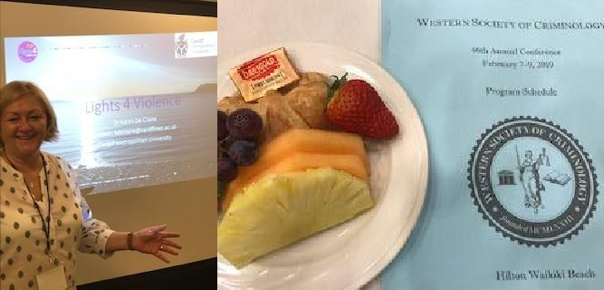
___________________________________________________
On May 11 in the University of Warsaw Professor Jacek Pyżalski during the 5th Congress of Polish Association for Quality in Foreign Language Teaching (PASE) has been presenting the lecture and took part in the discussion on young people and new media. The core questions have been around negative and positive impact of new media on young people. Lights4Violence methodological approach was set as example of good practice how new media can be utilized as a tool to conduct engaging educational workshops for young people. This is particularly true when important topics as peer violence are tackled. Although young people are digital natives, they need adult support to produce valuable content.
Panel discussion at Pase Congress
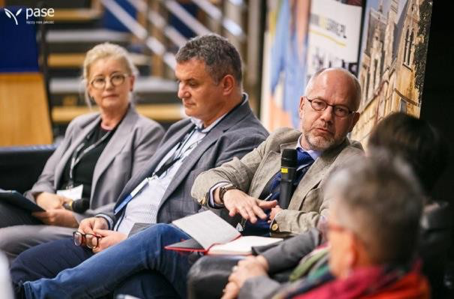
2.2. COMMUNICATION ACTIVITIES
Cineforum and final exhibitions of short films
Throughout the Lights4Violence network, the final cineforums showing the short films produced by students were a success. Each team found its own way to organize such events, thus complying with objectives and expactations shared with students.
In Romania, the project team organized “Filming together to see ourselves in a new present”, an event for presenting the shortfilms made by the students from the "Dimitrie Cantemir" High School (Iasi, Romania).
“Filming together to see ourselves in a new present”, Romania
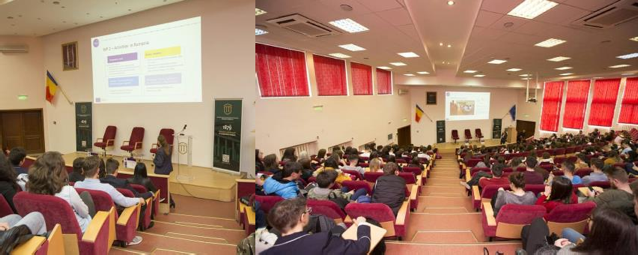
___________________________________________________
On the occasion of the last International Women’s Day (March 8), the IES Las Lomas highschool organized the exhibition of the short film that students recorded at the final of the project intervention. All of participants and teachers could watch the results and they were funny and interesting at the same time! At the end of the exhibition, the students received their certificates and a special gift from UA team: the L4V notebook! This notebook contained some pictures of the students working at the intervention. It was a special day!
Final Cinferoum, Spain

___________________________________________________
In Portugal, the nine short films produced by the Portuguese students were presented in 24th March to the entire community in a public exhibition were families, teachers and stakeholders have been actively involved.
Final Cinferoum, Portugal
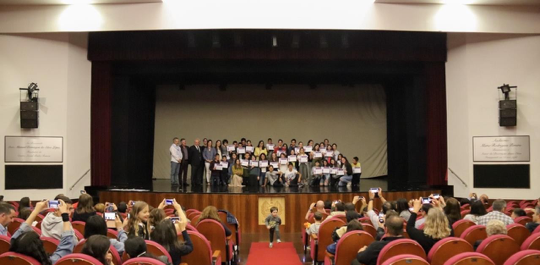
___________________________________________________
In Poland, the project team showed the effects of the project activities to the schools involved. Filming together against teen dating violence was a great adventure for students and teachers.
Final Cineforum, Poland
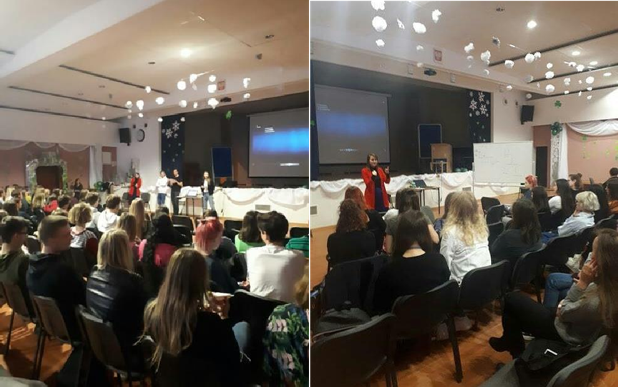
Other communication activities
The Polish team started to collaborate with the Equality and Diversity Policy Team in Poznan, a strategical unit which implements local public policies countereacting gender-based discriminations (among other forms of inequalities).
When the collaboration started…

___________________________________________________
On May 15 in the Theatre "Working Stage” in Poznań Dr. Iwona Chmura-Rutkowska conducted a meeting and discussion on peer relations and intimate relationships among teenagers. During the introduction she presented the Lights4Violence project as a good example of combining research with prevention and education. The discussion took place after the performance "Girls Describe the World" (dir. Aleksandra Jakubczak) and involved educators and psychologists working with youth in the field of violence and discrimination. An interesting and very emotional conversation was also attended by the audience, including teenage girls. The meeting was part of a project for young curators of culture from the Adam Mickiewicz University in Poznań.
Discussion after "Girls Describe the World" performance
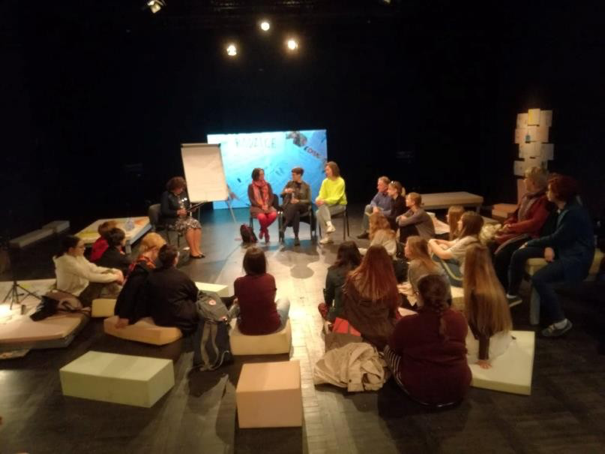
___________________________________________________
Just a few days before the International Day for the Elimination of Violence against Women, the Portuguese team of Lights4Violence, ISMAI/Maiêutica, held the Intervention on Intimate Gender Violence Conference. The event has joined governmental and non-governmental entities, national experts, researchers, professionals and students, promoting a critical space of share and debate.
Pictures from the event

2.3. FIELDWORK ACTIVITIES
Some insights on the intervention actitivies…
In Italy, intervention activities started in November 2018 in the Caetani High School (Rome) and engaged 121 students until March 2019. In the preliminary meetings, members of the LUMSA team presented the entire project to the students in each class, thus explaining how the first training activities would have led them to conceive and film videocapsules about teen dating violence and protective factors enhancing healthy love relationships.
Before Christmas holidays, the training activities were developed in six meetings scheduled in each class. Usually, students worked in small cooperative groups and relied on the activity journals provided by the project. Even if the time provided often was not enough, the working sessions dealt with the following topics and activities.
- • Main personal, relational and contextual assets which do enhance a positive development of adolescents: kids had to identify and familiarize with such assets, and matching them with their own personal competences in order to recognize benefits
- • Common languages against all forms of teen dating violence: students had to re-write the stories proposed by some comic strips in order to prevent or solve the controversial attitudes or violent behaviors therein represented
- • Main personal, relational and contextual assets which do enhance healthy love relationships: kids had to identify their own protective factors and recognize them as assets to be cultivated.
- • Myths and beliefs: students had to identify assumptions and clichés, recognize them as such and understand how these irrational convictions do operate in teen dating situations.
- • Anger and self-control: kids knew some concrete practices which do help to manage relational conflicts.
- • Social skills: students familiarized with different communicative styles and recognized the importance of assertiveness and self-confidence in conflict solving.
Students particularly appreciated when they had to associate pictures and assets (1st session) as they discussed a lot about what each photo actually represented. The also liked the comic strips activity (2nd session) as well as the techniques and methods to self-control anger (5th session). Nevertheless, some of them consider some comics too clichéd.
Training activities on protective factors against teen dating violence, Rome

In January, the videocapsule activities started in all classes and required more time than expected (between 11 and 13 hours of work in each class). Both videomakers and members of the LUMSA team developed the activities indicated by the manual provided by the project. While the formers provided a technical training, the latters reinforced students’ memory about assets and competences and helped them to be focused on the main topic of the project. The videocapsule activities were mainly structured in the following three phases.
1) Preproduction: students generated and shared ideas related to assets and healthy love relationships, identified the main arguments of their stories until converting them in the final plots that integrated all the prescribed ingredients (i.e., a couple, a conflict/problem, a personal asset, a relational and/or contextual asset). Then, they approached the literary and technical script of the plots.
2) Production: students rehearsed and filmed their own scripts together with videomakers who implemented this phase with technical tips and suggestions which made the activities even more funny and engaging for students.
3) Post-production: the technical personnel recorded and edited the video capsules until reaching one short film in each class. Students helped in determining the order of the video capsules, the soundtracks and the scene-changes. At the end, in each class the short films were broadcasted in order to gather students’ opinions and feedbacks.
Filming activities on healthy love relationships, Rome

Even if at the beginning students did not seem to be very engaged due to the running school self-managment week which coincided with project interventions, then students did become interested in the activities proposed, also thanks to the technical and creative commitment of videomakers. In the first sessions, it was difficult for students to construct a plot that integrates protective assets and competencies against violence in couple relationships. They were mainly focused on relational patterns which were very conflict oriented as well as on student’s real-life issues (arguments with boy/girlfriend faced through jealousy and verbal aggressiveness). So, in some cases LUMSA member stimulated students in order to re-think their ideas and to better address their plots toward the ingredients required. But after these first obstacles, the production phase was a success: some students were very excited to act while others very shy; some of them even became aware to have a talent for acting! And even the post-production activities were quite interesting. They were a very surprising moment for students because they didn’t expect such a very professional results of their own work. Moreover, LUMSA team carried out a debate after the broadcasting and asked students for their opinions about weakness, strengths and how to improve the project for future editions.
Students’ balance on the project intervention, Rome

___________________________________________________
In Poland educational and filming sessions have been organized in two schools (Liceum no. 1 and Liceum no. 4. in Poznań). Overall 122 students took part and were organized in 6 groups. The educational workshops were organized with the help of school teachers. The students were so active during the activities that there was almost every time the lack of time. Materials and techniques seem to be adequate or very adequate in the sessions, but sometimes students were bored with filling up tables and some stories were perceived as activities for younger students.
Students activities by groups
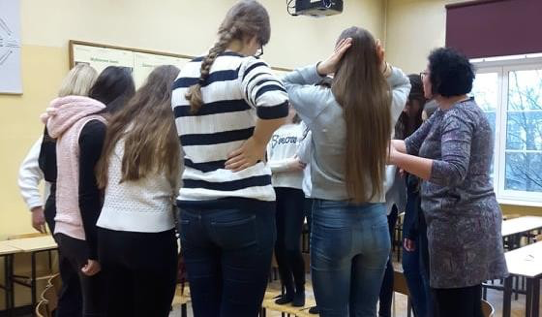
One of the school teachers provided the comment that is clearly showing the impact of the workshops: “A lot of personal comments from students' lives”. That meant that the content is close to young people’s everyday experiences. The stories provided brought a lot of fun but sometimes also some confusion. According to the teachers, “The stories were funny” or “too confusing” for students who sometimes “didn’t want to take this exercise seriously” or other times found “different solutions”. Communication was a key aspect very much appreciated by the students. The example of teachers opinion clearly underlines this: “I mentioned only about the ‘sandwich technique’, we spent a lot of time on the last exercise with positive feedback from pupils to pupils – they really enjoyed that and I thought it was very important; they liked the scenes about the communication styles”.
Students activities related to anger control
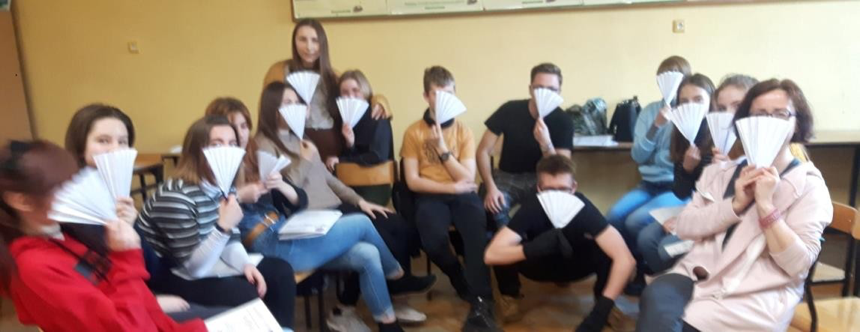
The filming workshops have been organized as one day activity with energetic young professionals from Smoła Studio Producing Company (real editors, actors, producers). It started from “theoretical” part but the most important was implementation od film art activities and presenting the content learnt during initial workshops. The good way to sum up is the following teacher’s comment: “We talk about violence, but it's still a taboo. Students don’t have opportunities to talk honestly with friends or parents and other adults. The workshop was for most of them the first opportunity to talk openly”.
___________________________________________________
In Alicante, the UA team finished the filiming activities in December. As in all countries, students had to develop arguments and hence write the script containing: 1) a couple conflict, 2) a family, community or school asset and 3) a personal competency that helps to resolve the conflict. All of the storylines were amazing! Here’s an example.
A girl waits at home for her girlfriend. She prepared a nice and special dinner. Her girlriend arrives and says that she can’t stay as she has another engagement. Then she leaves. The girl feels let down, and calls her friends who come over immediately. Her friends help her to see that the girlfriend often doesn’t respect her feelings, and it is not a lovely attitude. At first, the girl finds excuses for justifying her girlfriend, but she ends up seeing that her partner tends to avoid her. And This is not the relationship she wants. Her friends help her see that she deserves something better. They finally eat together. Later, her girlfriend shows up and is surprised to find her partner happily laughing with friends. The girl reproaches her girlfriend that she cannot just come and go when she wants, and that she doesn’t want to be with someone who doesn’t value her. Finally, she asks her to leave the house.
Filming activities in Alicante
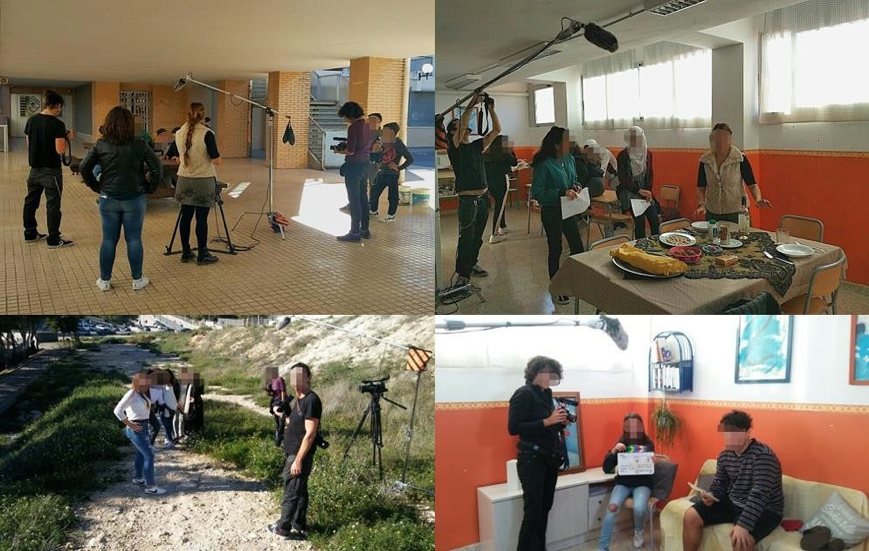
In this case, the conflict arises because a girl feels bad for being ignored by her girlfriend, who doesn’t take her feelings into account. The assets used for solving the situation are friendships: friends help the girl see that her relationship isn’t healthy. And the personal skills are empowerment, assertiveness, and self-esteem.
Overall, the UA team found that processing the argument with students never resulted in a completely definitive script as new ideas kept arising. Once the scripts were ready, it was needed to identify the most efficient group in each class in order to make the recording task more productive. Testing the characters was pivotal too, as well as being adaptativetowards unforeseen events, such as absence of some characters, lapse of memory about the script, missing materials among others.
___________________________________________________
In Romania, training with teachers was held in October 2018. Thirthy teachers from the Cantemir Highschool(intervention highschool) participated to the Seminar “Promoting Violence Protective Assets Together” and were trained on educational methods to be used during the workshops with students.
Bewteen November and December 2018, eight workshops were held and involved 150 students from intervention group. They were trained to improve their relational skills and communicative abilities for preventing physical, sexual and emotional violence in intimate partner relationships. The trainers were psychologists, physicians and school teachers.
Training activities with teachers and students, Romania
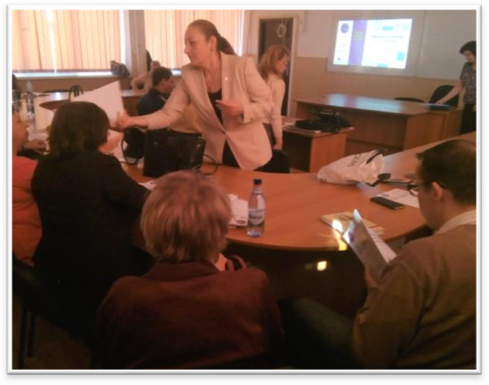
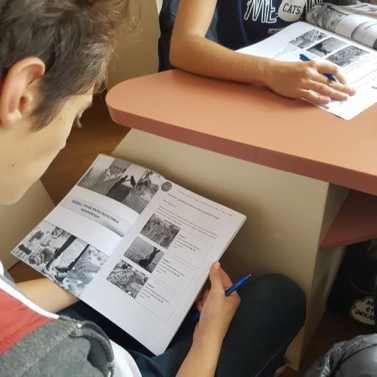
Later, in January 2019, students started to be trained in filming activities in order to set up and edit their videocapules. They were required to make films demonstrating that they have learned to recognize and not to tolerate dating violence. More than 200 hours were necessary to film 20 videocapsules. Students created scenarios, performed different roles, and filmed the videocapsules between February and March 2019. The filming workshops were supported by a team of television professionals, operators and cameramen.
Filming activities, Romania
Finally, five short films (each of 10 minutes) were produced illustrating the ability of young people to respond to the various forms of teen dating violence. The students proved in the short films their capacity to not accept gender-based discrimination and to find solutions in their selves, in community and in school to prevent dating violence. The final exihibition of the shortfilmes was on April, 8.
University of Medicine and Pharmacy, Iasi (Romania) - Film exhibition
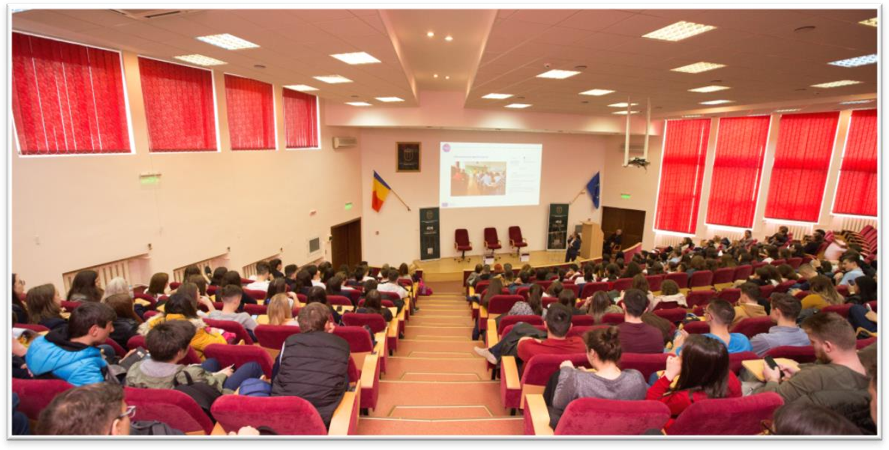
__________________________________________________
In Portugal, filming the short films was very enthusiastic and revealed students' commitment with the goals of Lights4Violence Project. 166 Portuguese participants involved in the Project have been filming nine short films where, according to their own narratives, they decided to show, among other competencies, how to solve conflicts in case of jealousy, control and absence of respect. They especially had enjoyed being in touch with multimedia techniques, and some of them developed a particular interest in knowing better the option to pursue a cinema career.
Filming activities in Portugal
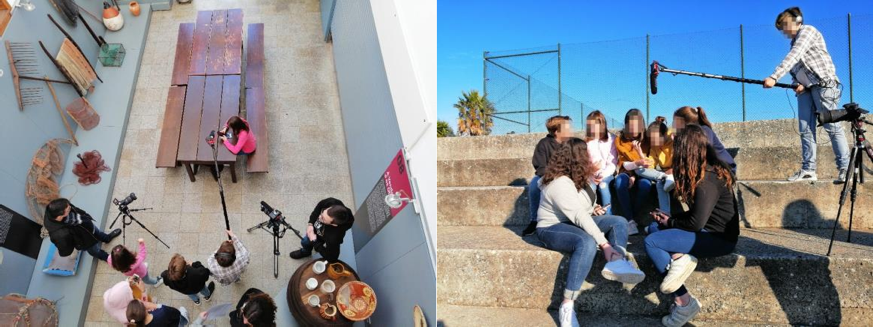
The nine final short films were presented in 24th March to the entire community in a public exhibition. Written and produced by the students, these films focused on the main themes and competencies developed during the workshops. Though, the stories they told reflects learning processes acquired in order to prevent dating violence and to promote positive youth development, revealing the importance of this kind of projects in schools’ settings.
The presence of families, teachers and stakeholders in the public exhibition was one the greatest moment of the entire Project.
Final exhibition in Portugal
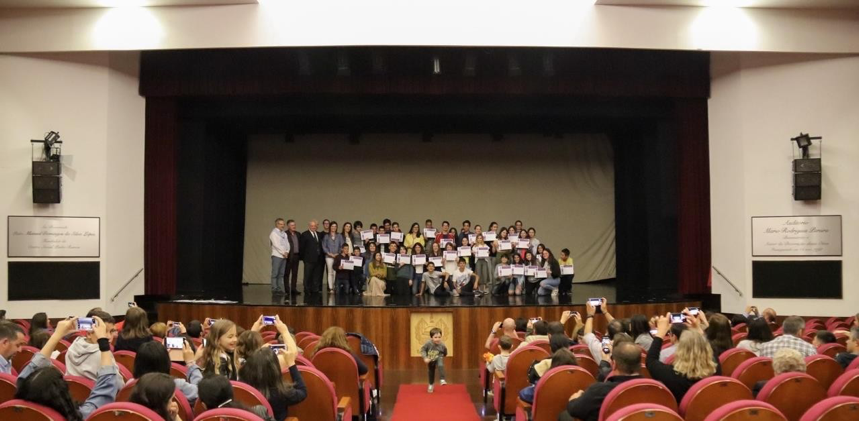
__________________________________________________
Survey and data analysis
The ISCII created a draft of the questionnaire in Spanish in SurveyMonkey and analysed which questions and scales presented some issues in a Pilot study (10th November 2018). The questionnaire was adapted and translated into English, and all countries translated the English version into their respective languages.
After including all the country questionnaires in SurveyMonkey, a Pilot survey was conducted in all countries. The pilot study had a sample of 130 students, with 54.2% girls. In order to develop the baseline study, some questions and scales were deleted after analyzing the pilot study results and we modified the questionnaire. Baseline data was collected from September 20th to December 10th 2018 for intervention group, and from September 28th to February 15th 2018 for control group. The final baseline database was formed by 1,555 students of all countries: Italy (19.0%), Poland (12.3%), Portugal (16.7%), Romania (22.1%), Spain (16.4%) and UK (13.5%). The mean age was 14.3 years and 60.0% were girls. The control group was higher than 50% in all countries, except Poland (37.0%), Portugal (48.1%) and UK (38.1%).
All scales showed an adequate internal consistency (Cronbach's alpha>0.7; range: 0.76-0.97). The mean values of the scales showed that the adolescents had high social support (mean M=252.5), high assertiveness (AISQ, M=84.0), an average self-esteem (M= 27.9), an average ability to resolve conflicts (M=59.3) and lower violent behavior (M=13.8), but sexism displayed moderate values (ASI, M=53.7, SD=18.4). All the scales showed significant differences between countries at 5% level. Boys showed a greater mean score of violent behavior (18.6 vs. 10.5), levels of sexism (58.8 vs. 50.6), aggressiveness (29.2 vs. 28.1) and self-steem (28.7 vs. 27.5) than girls (p<0.001). A higher mother’s level of schooling increased the mean score of social support, assertiveness skills, problem-solving skills and empathy; and was associated to reduce violent and aggressive behaviors. Having a dating relationship increased the scores of sexism (p <0.001) and aggressiveness (p <0.001), as well as decreased self-esteem (p = 0.003) and ability to resolve conflicts (p <0.001). Students who had suffered or have been aggressors of bullying/cyberbullying had higher values of sexism and aggressiveness, lower self-esteem and less ability to resolve social conflicts (p<0.05). Physical or sexual abuse in childhood was associated with lower social support, assertiveness skills, self-esteem, and happiness, and with higher violent and aggressive behavior. Also, ISCII set up a process-indicators questionnaire and uploaded the questionnaire in SurveyMonkey. When analysing the 6 sessions of training activities, the workshops' implementation was statistically different in all countries, for all process indicators. The mean session duration was 56.3 minutes, and in 56.1% of the sessions the duration was rated as scarce. All activities included in the manual were completed in 77.6% of the sessions. Most of the instructors (82.1%) said that they were satisfied or very satisfied with the session and in 87.8% of the sessions instructors rated the students’ satisfaction level as high or very high. The level of attention paid by the students was rated as high/very high in 85.5% of the sessions and 84.5% of the sessions were understood with no difficulty. The students’ participation level was high or very high in 86.0% of the sessions. For all sessions, the applied techniques materials and materials were rated as adequate or very adequate.
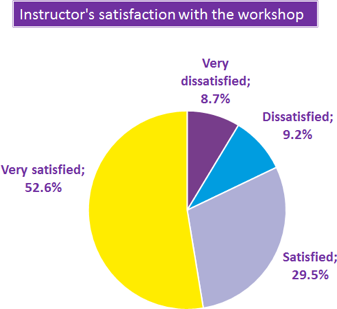
Finally, in the second wave’s questionnaire for students ISCII included some questions in order to explore students’ satisfaction about workshops and activities. Spain and Portugal collected data for the second wave at the intervention (Spain=85, Portugal=103) and control group (Spain=91, Portugal=99) from 22th February to 7th May 2019. A preliminary comparison between the first and the second wave in Spanish data showed a significant decrease in the scales about violence, and significant increase in assertiveness and empathy for intervention group. This change was significant in girls and non-significant in boys. Non-significant differences in scales were found in the control group.
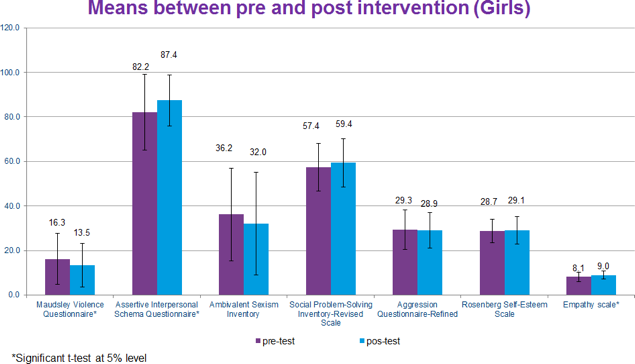
__________________________________________________
Project meeting
At the end of March 2019, all partners met in Cardiff. In the first sessions of the meeting they discussed about survey, training and filming activities carried out in the schools in each country. In this occasion, the main balance-based feedbacks arose and, according to them, issues to be integrated and/or changed in future projects were sketched out. So, the first day hosted a collective work and fruitful exchange about the project implementation, and many reflections and suggestions were gathered in order to assess the activities carried out and how to move forward in the next months. The second day, instead, partners focused on communication and dissemination activities as well as on financial issues and pending tasks. During this working session, the final meeting in Alicante was shaped!
Moments of the Cardiff Meeting, March 2019
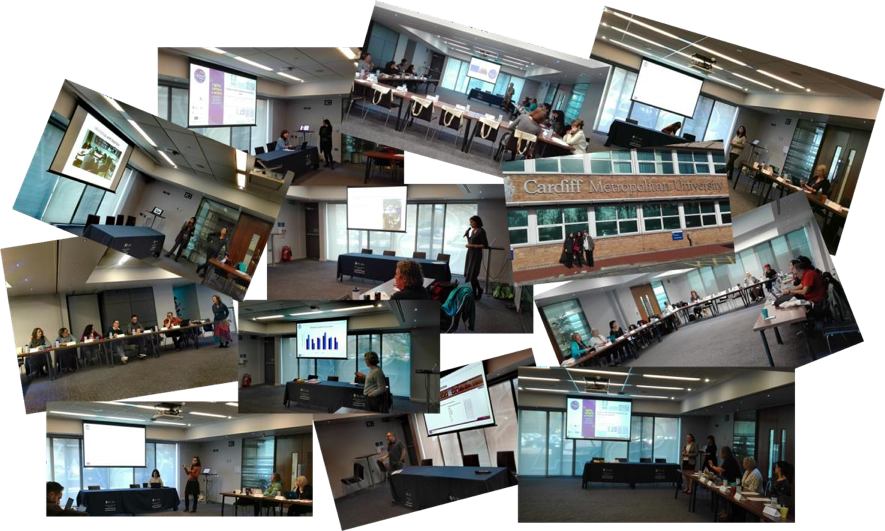
3. RELEVANT NEWS
In Portugal, on the occasion of the Valentine’s Day, the Secretary of State for Citizenship and Equality launched a national campaign with the goal to identify behaviors that represents clear signs of physical, psychological or sexual violence in a dating relationship. Involving public figures and digital influencers recognized by young people, the campaign was designed with the support of Commission for Citizenship and Gender Equality (CIG), various NGO’s and Academic Associations and Federations.
Pictures of the Portuguese campaign
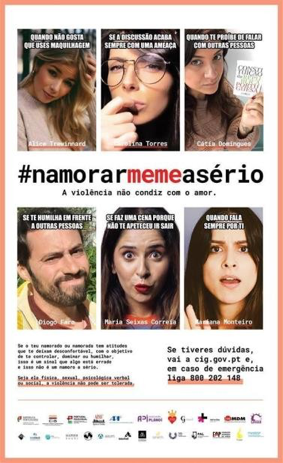
__________________________________________________
Genital mutilation, school desertion, forced marriages, clandestine births and abortions, domestic violence and abuse, infanticide. These are the main problems that over 70 million girls worldwide suffer. The Foudation "Terre des Hommes" recorded this in the 2018 Dossier "The condition of girls and little girls in the world" (you can download it at the at https://terredeshommes.it/indifesa/dossier/). At the same time, the Foundation still support the “Indifesa” campaign to guarantee girls education, health, and protection from violence, discrimination and abuse. Here the launching video: https://www.youtube.com/watch?v=-mYNggJEVnk
2018 Dossier "The condition of girls and little girls in the world"
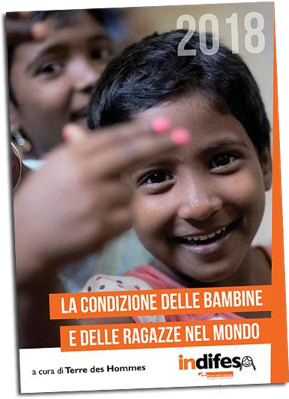
__________________________________________________
Violence against women (VAW) continues to be an alarming phenomenon affecting more and more people, and late legislative developments have, unfortunately, not been able to reduce the number of women who have been assaulted. One of the main problems that lead to the silence of VAW is the economic dependence of victims of aggressors. Thus, it is a fact that women who are subjected to violence and do not have a job are afraid to advertise the plight they sometimes go through daily, and therefore do not leave the home to escape abuses!
Under these circumstances, the state authorities decided to implement a new project dedicated to combating VAW and protecting the affected Romanians. On March 3rd, 2019, the signing ceremony for the project "VENUS - Together for a safe life" for victims of VAW took place. Project is estimated at 11 million euro and it will be funded from European funds, through the Human Capital Operational Programme. This project will protect affected women, both by offering them housing, providing psychological, legal assistance, reinsertion to the labour market and social reintegration. It aims at the transition of victims of VAW to an independent life through an integrated approach. Thus, the project will finance the creation and development of a network of 42 protected homes across the country in partnership with local public authorities. At the same time, survivors of VAW will benefit from vocational guidance services, vocational training, social and professional insertion, skills development for insertion into the labour market. They will also receive psychological, legal counselling and social assistance.
Nearly 7,000 survivors of VAW will be included in a new government program that will allow them to receive accommodation in social housing and psychological counselling. Signing the "Together for a safe life" project is a solid premise that thousands of people - women, men and children - will be protected from VAW and will regain their trust and dignity.
The project "VENUS - together for a safe life":
- • Funded by: Human Capital Operational Program
- • Value: 11 million euros
- • Implementation period: 48 months
- • Over 7,000 supported people:
- • 6,636 victims of domestic violence;
- • 366 specialists in the field of combating domestic violence.
More info at: https://www.nineoclock.ro/2019/03/05/european-funds-minister-head-of-the...
__________________________________________________
New technology has made pornography increasingly accessible to young people, and there is growing evidence that has identified a relationship between viewing pornography and violent or abusive behavior in young men. This article reports findings from a large survey of 4,564 young people age 14 to 17 in five European countries. It shows the relationship between regular viewing of online pornography, sexual coercion and abuse and the sending and receiving of sexual images and messages, known as “sexting.” Boys’ perpetration of sexual coercion and abuse was significantly associated with regular viewing of online pornography. Viewing online pornography was also associated with a significantly increased probability of having sent sexual images/messages for boys in nearly all countries. In addition, boys who regularly watched online pornography were significantly more likely to hold negative gender attitudes. Want to learn more about this research? Read more at: https://journals.sagepub.com/doi/abs/10.1177/0886260516633204?journalCod...
__________________________________________________
“D.i.Re, Women on the Net against Violence” is the Italian association responsible for the "Shadow Report" aimed at the "Group of experts on the fight against violence against women and domestic violence" (GREVIO), the independent organism of the Council of Europe responsible for monitoring the implementation of the Istanbul Convention in all the countries that have ratified it, including Italy.
Cover of the GREVIO Report
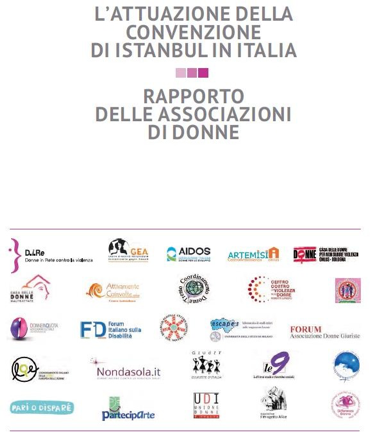
The Italian 2018 report offers a worrying picture regarding Italian society as a whole, as it is still characterized by a strong sexism. According to the report, in fact, gender-based prejudices, mainly referred to the stereotypical roles assigned both to men and women, are reproduced from the earliest educational and scholastic texts, and are reflected in the verbal messages and images of all types of media. This is the reason why the authors of the text strongly recommend to iomplement media-based intervention activities in order to prevent sexism and misogyny in general, and to struggle against online violence. They also invite to adopt mechanisms for monitoring and sanctioning sexist media and communication behaviors. Furthermore, the implementation of practices for preventing violence and sexism should take place in all educational levels, as new generations can be formed differently and, therefore, can become drivers of a cultural and social change. Infact, authors recommend to make the application of the National Guidelines approved in 2017 ("Educating for respect: for gender equality, prevention of gender violence and all forms of discrimination") better and more effective, as they are tools that have already given the green light to the implementation of school policies, action plans and appropriate educational tools fighting against sexist stereotypes and preventing gender violence among youths.
Therefore, in such a scenario, projects like Lights4Violence that both analyze and intervene, and for that matter, by adopting a proactive approach (protective factors) rather than a preventing one (risk factors), are really needed to complement the top-down and bottom-up initiatives already under way. Here you can download the full Report in English and Italian: https://www.direcontrolaviolenza.it/grevio-rapporto-ombra/
__________________________________________________
The Projects Uni+ 2.0, Sexism Free Night and EIR carried out by three Portuguese NGOs joined together against sexual violence by intervening in academic festivities, festivals and night time entertainment contexts. Through the PONTO LILÁS, the promotors pioneeringly aim to raise awareness about the importance of fighting youth violence, including dating violence.
Some pictures directly from PONTO LILÁS, Portugal

__________________________________________________
“Si te sientes ahogado no es amor” [If you feel suffocated, it's not love]. Such a campaign aims to raise awareness about gender violence among adolescents and highschool students of Murcia (Spain). More specifically, it focuses on supporting secondary schools in developing proposals that promote equality between girls and boys and the prevention of gender violence with actions against machismo. More info at:
https://www.laopiniondemurcia.es/cartagena/2019/02/07/campana-conciencia...
Campaign launch, Spain
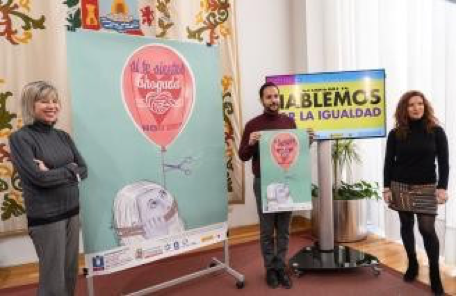
__________________________________________________
Teen dating violence is defined as the perpetration of physical, psychological and/or sexual violence of one adolescent member of an intimate relationship on the other (Health Canada, 1995). This is an area of research that is relatively recent and seems to emerge alongside with recent changes observed in the epidemiological profiles of intimate partner violence.
Intimate partner violence and gender violence usually come about gradually. In many cases such pheonomena does not appear until a couple begins living together (González & Santana, 2001). Rubio-Garay, Carrasco, Amor and López-González (2015) classified promoting and inhibiting factors of couple violence as (inter)personal and situational. The former includes hostile attributes, attitudes and beliefs which enhance the use of violence and sexism. This is the reason why machismo is considered a key aspect both of intimate partner violence and gender violence. In fact, machismo consists of a set of beliefs, attitudes and behaviors grounded in the supposed superiority of men in many male-dominated field (Ramírez, Robayo, Cedeño & Riaño, 2017). This means that machismo is partially shaped by the sociocultural construction of masculinity and its performances which, in turn, marks social inequalities between men and women structuring current society (Schongut, 2012). The dominant idea and practices of masculinity associate men to force, risk, independence and courage, among others, while the main idea and practices of femininity associate women to passivity, weakness, caring activities among others (Garzón, 2015).
Such patterns shape norms and beliefs about what “being a man” and “being a woman” mean, and may influence teens’ attitudes and behaviours. On the other hand, personal experiences of gender and/or intimate partner violence also gives way to machista attitudes and gender inequality, and in the worst cases may even foster adolescents to perpetrate violence and/or to suffer it in a victimistic mood. Moreover, experiencing gender and/or intimate partner violence in adolescence can have long-term effects and increase the risk of alcoholism, depression, suicidal ideation and greater victimization in young adulthood (Exner-Cortens, Eckenrode & Rothman, 2013). It doesn’t impact only physical health, but also mental health (Taylor, Stein & Burden, 2010).
Given its great impact on health, it is necessary to approach intimate partner violence from an educational perspective, based on equality and the promotion of healthy and positive relationships. Interventions carried out with adolescents aim to change attitudes that justify violence, to promote social skills and to support communication and conflict resolution. Thus, they also provide knowledge of the assets and resources whic are available in order to face this type of violence (Macgowan, 1997; Avery-Leaf, Cascardi, O’Leary, & Cano, 1997; Foshee et al., 1996, 1998, 2000; Wekerle & Wolfe (1999); Florsheim, McArthur, Hudak, Heavin & Burrow-Sánchez, 2011; Foubert, 2000; Gidycz et al., 2001; Jaycox et al., 2006; Kuffel & Katz, 2002; Miller, 1999; Miller et al., 2012; Pacifici, Stoolmiller & Nelson, 2001; Wolfe et al., 2003; Wolfe et al., 2009; Hernando, 2007).
Considering all these issues when carrying out an intervention with teens can help to reduce violence while promoting healthy interpersonal relationships. And approaching interventions from a more positive perspective fostering protective factors (assets and skills) is strongly encouraged.
References
Avery-Leaf S, Cascardi M, Oleary KD, Cano A. (1997). Efficacy of a dating violence prevention program on attitudes justifying aggression. Journal of Adolescent Health, 21(1), 11–7.
Exner-Cortens, D., Eckenrode, J., & Rothman, E. (2013). Longitudinal associations between teen dating violence victimization and adverse health outcomes. Pediatrics, 131, 71–78.
Florsheim, P., Mcarthur, L., Hudak, C., Heavin, S., & Burrow-Sanchez, J. (2011). The young parenthood program: Preventing intimate partner violence between adolescent mothers and young fathers. Journal of Couple and Relationship Therapy, 10(2), 117-134. https://doi.org/10.1080/15332691.2011.562823
Foshee VA, Bauman KE, Arriaga XB, Helms RW, Koch GG, Linder GF. (1998). An evaluation of Safe Dates, an adolescent dating violence prevention program. American Journal of Public Health88(1), 45–50.
Foshee VA, Bauman KE, Greene WF, Koch GG, Linder GF, MacDougall JE. (2000). The Safe Dates program: 1-year follow-up results. American Journal of Public Health, 90, 1619-22.
Foubert JD. (2000). The longitudinal effects of a rape-prevention program on fraternity men’s attitudes, behavioural intent, and behavior. Journal of American College Health, 48 (4), 158–63.
Gidycz CA, Lynn SJ, Rich CL, Marioni NL, Loh C, Blackwell LM, et al. (2001). The evaluation of a sexual assault risk reduction program: a multisite investigation. Journal of Consulting and Clinical Psychology, 69(6), 1073–8.
González, R., & Santana, J.D. (2001). La violencia en parejas jóvenes. Psicothema, 13(1), 127-131.
Health Canada (1995). Dating violence. National Clearinghouse on Family Violence. En A. Hernando (2007). La prevención de la violencia de género en adolescentes. Una experiencia en el ámbito educativo. Apuntes de psicología, (3), 325-340.
Hernando, A. (2007). La prevención de la violencia de género en adolescentes. Una experiencia en el ámbito educativo. Apuntes de Psicología, (3), 325-340.
Jaycox L, McCaffrey D, Eiseman B, Aronoff J, Shelley G, Collins R, et al. (2006). Impact of a school-based dating violence prevention program among Latino teens: randomized controlled effectiveness trial. Journal of Adolescent Health, 39(5), 694–704.
Kuffel SW, Katz J. (2002). Preventing physical, psychological, and sexual aggression in college dating relationships. Journal of Primary Prevention, 22(4), 361–73.
MacGowan M. (1997). An evaluation of a dating violence prevention program for middle school students. Violence and Victims, 12(3), 223–35.
Miller JR. A Social Learning Perspective Toward the Prevention of Dating Violence: an Evaluation of a Group Counseling Model [PhD thesis]. Miami, FL: Miami Institute of Psychology Studies, 1999.
Miller E, McCauley H, Virata MC, Decker M, Tancredi D, Moideen F, et al. Coaching boys into men: preliminary success of a sexual violence prevention program. Journal of Adolescent Health2011; Vol. 48, issue 2 Suppl: S85–6.
Pacifici C, Stoolmiller M, Nelson C. (2001). Evaluating a prevention program for teenagers on sexual coercion: a differential effectiveness approach. Journal of Consulting and Clinical Psychology, 69(3), 552–9.
Schongut (2012). La construcción social de la masculinidad: poder, hegemonía y violencia. Psicología, conocimiento y sociedad, (2), 27-65.
Taylor, Stein & Burden (2010). Exploring gender differences in dating violence/harassment prevention programming in middle schools: results from randomized experiment.
Ramírez, Robayo, Cedeño & Riaño (2017). El machismo como causa original de la violencia intrafamiliar y de género. CienciAmérica, 6(3).
Rubio-Garay, Carrasco, Amor & López-González (2015). Factores asociados a la violencia en el noviazgo entre adolescentes: una revisión crítica. Anuario de Psicología Jurídica, 25, 47-56.
Wekerle, C & Wolfe DA. (1999). Dating violence in mid-adolescence: theory, significance, and emerging prevention initiatives. Clinical Psychology review, (19), 4, 435-456.
Wolfe DA, Crooks C, Jaffe P, Chiodo D, Hughes R, Ellis W, et al. (2009). A school-based program to prevent adolescent dating violence.Archives of Pediatric Adolescent Medicine, 63 (8), 692–9.
Wolfe DA, Wekerle C, Scott K, Straatman AL, Grasley C, Reitzel-Jaffe D. Dating violence prevention with at-risk youth: a controlled outcome evaluation. Journal of Consulting and Clinical Psychology2003;71(2):279–91.
__________________________________________________
Gay Men’s Discourses was a study carried out in Portugal by Rita Elísio, Sofia Neves and Rita Paulos (2018). In terms of characteristics and dynamics, results of two focus groups with 17 young men, aged 19 to 29 (M=24.06), suggest that the violence occurring in intimate same-sex relationships is similar to that of couples of different sexes, although some specificities may be identified. In fact, stigmatisation, invisibility, and isolation tend to be characteristics frequently associated to this kind of intimate partner violence. More info: https://journals.openedition.org/rccs/8149
__________________________________________________
"Bullying and cyberbullying - face to face with reality" was the event which took place on 27 February 2019 at the "Richard Wurmbrand" College in Iasi (Romania). The theme was debated by more than 200 teachers, education specialists and representatives of local authorities participating in a methodical circle of coordinating teachers in the Prevention and Reduction Committee violence in schools. More info: https://www.ziaruldeiasi.ro/stiri/cerc-metodic-despre-a-bullying-si-cibe...
__________________________________________________
The 2017 Report on “Intimate partner digital abuse”, edited by the Center for Innovative Public Health Research and the Data & Society Research Center, shows that "12% of teenagers who have ever been in a romantic relationship have experienced intimate partner digital abuse". Digital abuses experiences include: being monitored online or by phone, being purposefully embarrassed online, being called offensive names, and being stalked. More info at: https://datasociety.net/pubs/oh/Intimate_Partner_Digital_Abuse_2017.pdf
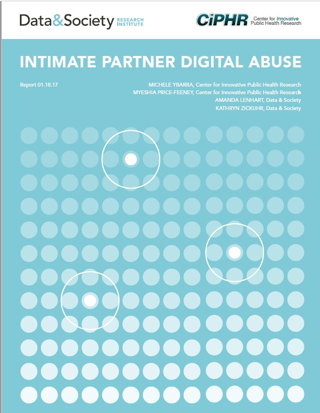
__________________________________________________
The UNi+ 2.0 - Dating Violence Prevention Program in university context, promoted by Associação Plano i, launched on February 14 a video campaign aiming to draw attention on the occurrence of multiple forms of dating violence among youth. Have a look at the video on: https://www.youtube.com/watch?v=Cdz7iFKke0U&feature=youtu.be
A video frame
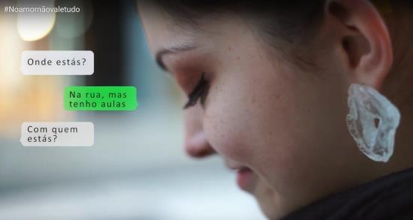
__________________________________________________
Ireland criminalized emotional abuse with new domestic violence law, approved at the end of 2018. The Domestic Violence Act 2018 provides new protections for victims of 'coercive control,' a type of emotional and psychological abuse aimed at stripping a person of their self-worth and agency. Although psychological and emotional abuse -- including controlling behavior, isolation, and threats of violence -- can be more difficult to recognize than physical violence, it can be just as damaging, experts say. More info at: https://edition.cnn.com/2019/01/02/health/ireland-coercive-control-domes...
__________________________________________________
In Catalonia (Spain), recent regional data shows an increase of 45% of victims of sexist violence committed by youths from 14 to 17 years old in the Autonomous Community of Catalonia (see: https://www.elperiodico.com/es/sociedad/20190131/violencia-machista-meno...). Whereas in 2016 there were 74 young girls victim of gender violence that were attended by the Mediation and Technical Advice Service of the Ministry of Justice, in 2018 figures were 107. Local authorities have expressed their worries about this situation. These data have appeared at the same time that it has been known that in Reus (a village in Catalonia), a 17-year-old girl has been murdered by her 19-year old partner, who has committed suicide. On this matter, the Social Psychologist Gemma Altell wrote: “We speak to the girls of empowerment, of freedom, but the reality returns patriarchy, judgment, submission and, in the case of Reus, murder” (see: https://amp.elperiodico.com/es/opinion/20190131/articulo-opinion-violenc...). Experts in education and social entities that work with adolescents have appealed for long-term school projects that break stereotypes and approach young people to an education in equality.
Frame from the newspaper’s info graphic
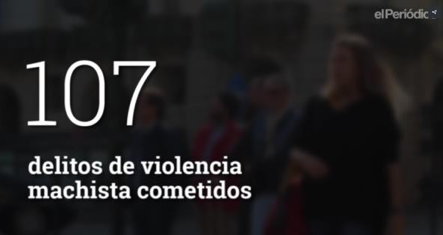
__________________________________________________
According to the survey carried out by "Terre des Hommes" and its Italian Observatory on Violence and Stereotypes among Adolescents, the phenomenon of sexting is more widespread in Italy than expected. At least 1 out of 5 girls (19%) admits to having practiced it, while 4 out of 10 girls say they have seen intimate photos or videos of both themselves and friends on social networks or in texts messaging. And more than a third of the interviewees (37.4%) consider girls making a hot video or photo as "easy girls. This means that digital abuse and attitudes towards it are social problems which need updated interventions able to cope with the new forms of gender violence that occur in digital environments seamlessly with offline gender violence.
See the summary of the results of the whole survey here:
https://terredeshommes.it/comunicati/adolescenti-sempre-piu-social-ma-la...
“Indifesa” Observatory on adolescents and sexting, Italy
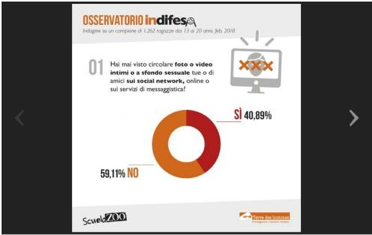
Moreover, the Terre des Hommes Foundation closed the "Invisible to the eyes" crowdfunding campaign aimed at opening the "Casa di Timmi", a first welcome community in Italy for children aged from 0 to 6 years who are victims of maltreatment or expelled from the family.
Family violence is one of the most influent risky factors of teen dating violence and unfortunately is often invisible until becoming dramatically evident when it is too late. As doctors and psychologists can identify it early and offer qualified assistance, the Terre des Hommes Foundation, together with a network of pediatric hospital excellence throughout the Italian territory, has worked extensively on the issues of prevention and combating violence against children in these years. The project "Casa di Timmi" will involve educators, psychologists, pediatricians, families and volunteers in order to provide complete assistance to children and their families.
“Invisble to the eyes” crowdfounding campaign, Italy
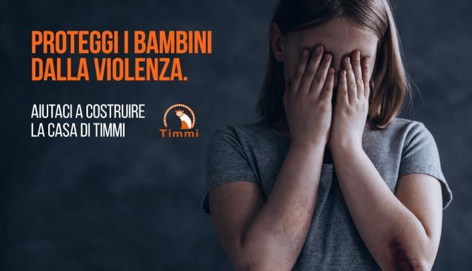
__________________________________________________
Intimate partner violence (IPV) is the most common form of violence against women in the world, with nearly 1 in 3 women age 15 or older experiencing physical or sexual IPV. Shockingly, up to 90% of injuries sustained in IPV are to the head, face, and neck. In United States, using annual estimates of severe physical violence (totaling 3,200,000 women), about 1,600,000 women are estimated to sustain repetitive IPV-related traumatic brain injuries (TBIs) in comparison to the total annual numbers of TBIs reported for the military (18,000). More info at: https://www.forbes.com/sites/nicolefisher/2019/04/08/a-global-public-hea...
__________________________________________________
Domestic violence is an important public health problem and an intolerable and unacceptable social reality which demands a strong action and the congregation of multiple efforts of the whole society to defend the integrity and the dignity of women (Walby & Towers, 2017; WHO, 2002). Facing the highly significant number of mortal victims of domestic violence since the beginning of 2019, the Portuguese Government decreed March 7 as the Day of National Grief in honor of the victims of domestic violence and their families (Decree nº 8/2019, March 6).
Recently, Portuguese Council of Ministers approved a set of measures to prevent and combat domestic violence. The measures focus on three priorities areas: 1) improving collection, processing and cross-checking of official quantitative data; 2) improving victims’ protection mechanisms within 72 hours after filling a complaint and 3) reinforcing training models, including other areas of intervention (e.g., follow-up, care for victims, justice response).
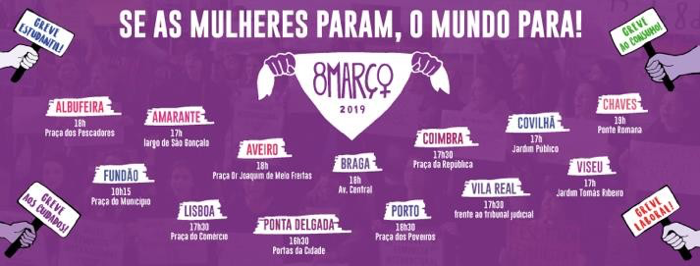
However, social and political changes do not end here. International Women's Day celebration was also historical in Portugal this year. The country joined the appeal of the International Feminist Strike, an international movement that fight against gender-based violence, which has become increasingly serious and deadly in response to the progressive emancipation of women throughout the world. The Feminist Strike in Portugal, which was organized by approximately 30 collectives, tooked place in 13 cities: Albufeira, Amarante, Aveiro, Braga, Coimbra, Covilhã, Évora, Fundão, Lisboa, Porto, São Miguel-Ponta Delgada, Vila Real and Viseu. For many people Feminist Strike of March 8 is seen as a turning point, not only by the millions of women who mobilized in many countries of the world, but also for having managed to organize historical demonstrations in our country such as the accession of five unions. From this year on, International Women's Day is no longer associated with the market of flowers and candies to become a day of struggle, resistance and demand for women rights.
References
Diário da República (2019). Decreto n.º 8/2019, de 6 de março. Lisboa: Diário da República.
República Portuguesa (2019). Comunicado do Governo Português.
Walby, S., & Towers, J. (2017). Measuring violence to end violence: mainstreaming gender. Journal of Gender-Based Violence, 1(1), 11-31.
World Health Organization (2002). World report on violence and health. Geneva: WHO.
__________________________________________________
Welsh Government published the "Rapid Evidence Assessment: What works with domestic abuse perpetrators?". A number of the key findings echo the message that L4V is bringing to the schools in Wales. It highlights prevention and early intervention, the need to take a whole system approach and the importance of evaluation. The publication is part of the work being carried out in the context of the implementation of the Violence Against Women, Domestic Abuse and Sexual Violence (Wales) Act 2015. The act defines the wider strategy of developing a culture that challenges abusive behaviour, where everyone has the right to live fear free.
Report cover
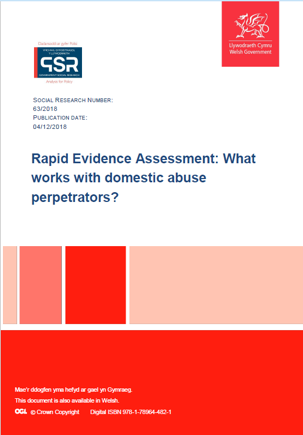
__________________________________________________
Internet has impacted a lot of dimensions of teenagers’ life, such as relationships with peers and adults and, namely, intimate relationships. It also gave “a new façade” to traditional negative phenomena, such as bullying that now can have its cyber form of electronic aggression (i.e., “cyberbullying”). Such phenomena can be analyzed also according to a gender perspective as patterns of the Internet usage vary among boys and girls. This is the case of the newest research data of the “EU Kids Online” Project. In Poland, the research was conducted in the first part of the year 2018 and was conducted on the representative sample of Polish children and teenagers aged 9-17. Overall, more and more young people use a mobile device to access the Net (in fact, almost 83% use smartphone every day or even more often to be online) while they are leaving PC or laptops. More specifically, about 52% of boys and only 29% of girls use daily a PC/laptop to connect to the Internet. Possession of a profile on a social network site is very widespread. In the entire sample, 72.6% have one and there are no differences between boys and girls. Younger children (9-10 y.o.) had their profiles significantly less often than teenagers (11-17 y.o.) – (80% versus 48%). Important statistical difference was observed in the younger group: boys are more likely to have a profile compared to girls, and the difference was in this in the case of almost 10 percentage points (girl 43%; boys 53%). Regarding digital skills, girls are more competent to change settings (crucial to avoid cyberbullying) on a social network site, while boys are more likely to check the costs of mobile applications, publish movies or music on the internet, check the truth online information, and edit content. It is worth remembering that such competences can be both advantageous (one producing positive online content) or may be used negatively (for instance while producing visual cyberbullying content).
Research cover
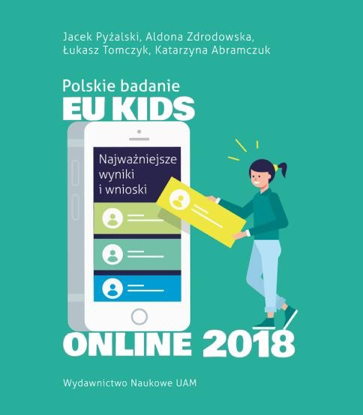
__________________________________________________
Bad news from The Guardian: https://www.theguardian.com/world/2018/dec/06/men-underestimate-level-of... Despite the #MeToo campaign aimed at raising awareness about how much harassment is widespread, in many US and EU countries both genders underestimate levels of sexual harassment experienced by women since the age of 15, but men more so than women.
__________________________________________________
A recent scientific publication reported on the preliminary results of another dating violence prevention program implemented in Seville, Spain. This program was run in 908 teens, compared to 856 teens in the control group, all aged 11 to 19 years. It included classroom and internet activities such as group exercises, watching videos, role-playing and decision-making games. The paper reports positive, promising results found in the areas of self-esteem, anger regulation and myths about romantic love.
More info at: https://doi.org/10.1371/journal.pone.0205802
4. FORTHCOMING
Next 16-18 of October, a new project meeting will be hold in the Faculty of Health Science of Alicante University. In this meeting, we will integrate an International Conference about “Dating Violence and the Role of Education”. We plan one day and half seminars for this international event and one day and half internal meeting for the members of Lights4Violence Consortium. The International Conference will be a way to put in common the main project results in the different targeted cities and to create new research networks with other research groups who are also working in Dating Violence prevention and Adolescents Healthy Relationships promotion programs. All sessions will be recorded to be published in our project website and will be transmitted by video-streaming!
If you believe that promoting protective factors, such as trust, recognition of diversity, and mutual respect and friendship is a way to prevent teen dating violence, follow us on Facebook (www.facebook.com/Lights4Violence/) and Instagram (Lights4Violence), and please visit our website www.lights4violence.eu and blog http://www.lights4violence.eu/blog
